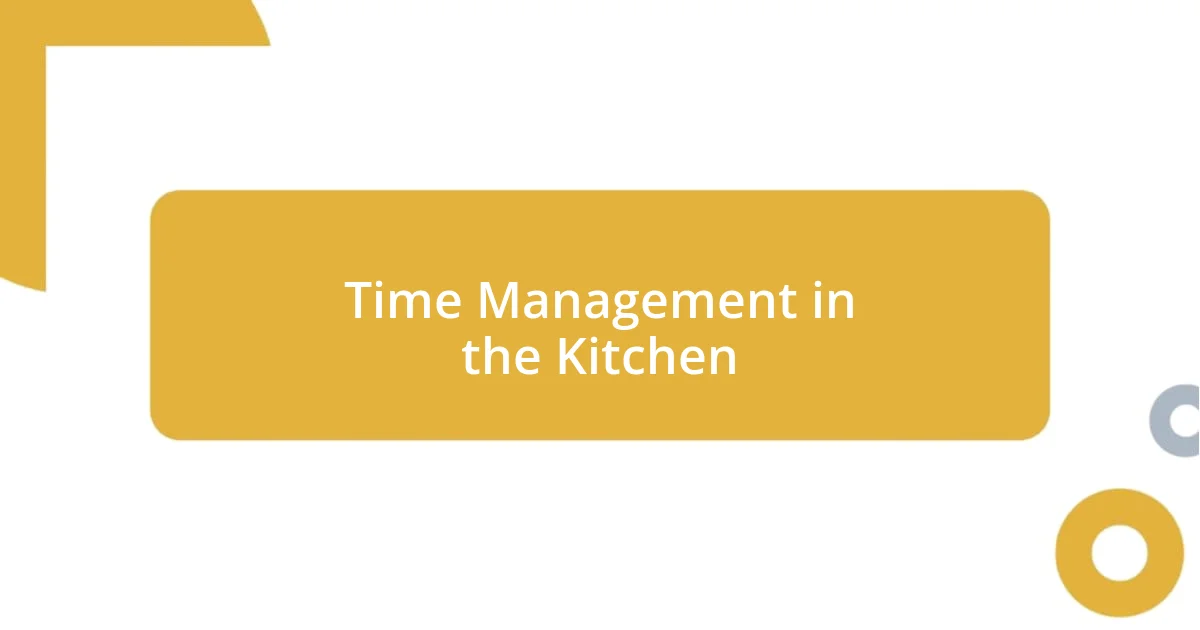Key takeaways:
- Mise en place enhances kitchen efficiency, reducing stress and fostering creativity.
- Fresh ingredients significantly elevate flavor, texture, and nutrition of dishes.
- Building a culinary network facilitates shared knowledge and collaborative opportunities for growth.

Insights from Professional Chefs
One memorable lesson I learned from a professional chef revolves around the importance of mise en place, or “everything in its place.” It became clear to me that this isn’t just about organization; it’s about creating a calm and efficient environment in the kitchen. Have you ever experienced a rush while cooking? I bet it’s chaotic when you can’t find the right tools or ingredients. By setting everything out beforehand, the chef explained, you minimize stress and maximize creativity.
Another insight that struck me was the idea of taste as a language. A chef once shared how every dish tells a story, with flavor profiles that evoke emotions and memories. This concept shifted my perspective entirely—how often do we consider what our food communicates? During a tasting, I felt transported to different places as each bite elicited distinct memories. It’s fascinating how food can connect us to our past experiences.
Finally, I learned about the vulnerability that comes with cooking. A chef opened up about the pressures they face, often feeling exposed when presenting their creations. This revelation was eye-opening—how many of us are hesitant to share our talents for fear of judgment? It made me realize that embracing our imperfections in the kitchen, or in life, can lead to the most authentic and beautiful results.

Techniques for Perfect Cooking
Effective cooking techniques can truly transform a meal. One key technique I learned is the importance of controlling temperature. I vividly remember a time when a chef demonstrated how searing meat at the right temperature locks in moisture and flavor. That sizzling sound as the meat hits the pan is music to the ears! Have you ever pulled meat out too soon, only to find it was dry? Maintaining the right heat is crucial for achieving that perfect, juicy texture.
Another fundamental technique is the art of seasoning. I once watched a chef sprinkle salt onto ingredients and then explain how it draws out natural flavors. It hit me then: seasoning is not merely a task, but rather an essential step that enhances every layer of a dish. Have you ever tasted your meal and thought it was missing something? Often, it’s just a matter of adjusting your seasoning to elevate the dish. It’s incredible how a dash of salt or a hint of acidity can transform your culinary creation.
Let’s not forget the importance of patience in the cooking process. I recall a chef patiently stirring a risotto, explaining that rushing it can lead to a sticky and uneven final product. Cooking isn’t just a science; it’s an art that requires attention and care. When I started embracing this principle, I discovered a newfound appreciation for the simple joy of cooking. Have you taken a moment to savor the process instead of just rushing to the finish line?
| Technique | Key Insight |
|---|---|
| Controlling Temperature | Locks in moisture and flavor |
| Seasoning | Enhances natural flavors |
| Patience | Aims for perfect texture and depth |

Balancing Flavor and Texture
In my experience, finding the right balance between flavor and texture is what truly elevates a dish. I recall assisting a chef who meticulously layered flavors and textures in a simple vegetable dish. He emphasized how each element—crunchy roasted nuts, silky pureed squash, and fresh herbs—interacted to create a memorable experience. The contrasting textures not only delighted the palate but also made the dish visually appealing. It reinforced for me that cooking is as much about tactile sensations as it is about taste.
When you think about flavor and texture, consider these key aspects:
- Contrast is Key: Combining different textures, like creamy and crunchy, can make a dish exciting.
- Flavor Depth: Use layers of flavors—think of a rich broth topped with fresh herbs—to keep each bite interesting.
- Consider Freshness: Fresh ingredients often offer better texture and vibrant flavors, enhancing the overall dish.
- Think of Temperature: Serving hot and cold elements together can create a lovely sensation on the palate, like a warm chocolate cake with a scoop of cold ice cream.
Remember, it’s these nuances that make a meal special, inviting you to savor each bite.

Importance of Fresh Ingredients
Fresh ingredients are truly the backbone of any remarkable dish. I still recall my first encounter with freshly harvested vegetables at a local farmer’s market. The vibrant colors and crisp textures were an immediate contrast to the tired produce I often found in grocery stores. It’s amazing how the taste of a sun-ripened tomato or a just-picked basil leaf can send your taste buds on an exhilarating journey. Have you ever tasted a dish where every bite felt like a burst of nature? That’s the magic of fresh ingredients.
Moreover, the difference in flavor intensity is striking when using fresh components. I remember experimenting with a pesto recipe, using basil pulled straight from a garden rather than store-bought. The fresh basil’s bright, aromatic notes were undeniably richer and more pronounced. This experience taught me that the quality of ingredients can elevate a simple pasta from mundane to extraordinary. Isn’t it fascinating how something as simple as a herb can elevate the entire dish?
In cooking, freshness not only enhances flavor but also impacts texture and nutrition. I vividly recall a chef frowning at pre-packaged salads, noting that once greens start wilting, they lose their vibrant crunch and crucial nutrients. This lesson became a guiding principle for my home cooking. I often think about how many nutrients are lost in store-bought convenience foods. Next time you’re preparing a meal, ask yourself: How can fresh ingredients transform my dish and health? The answer often lies in the bright, fresh produce waiting just outside your door.

Time Management in the Kitchen
Managing time in the kitchen is an art form that can make or break a meal preparation. I remember the first time I tried to tackle a multi-course dinner without a solid plan—it was chaotic! I ended up scrambling and completely lost track of what needed attention when. It taught me that prioritization is key; focusing on dishes that take longer to cook first can alleviate that frantic feeling.
An effective technique I learned is the importance of mise en place, which is French for “everything in its place.” One busy evening, I watched a seasoned chef arrange all his ingredients before starting. This not only streamlined his cooking process but also kept him grounded and aware of what he had. When I began to adopt this practice, it transformed my cooking experience—everything flows smoother, and I’m less likely to forget an ingredient or step.
I’ve also found that setting timers can be a lifesaver. Once, I was juggling multiple pots on the stove, reminded of a comical cooking show scene where things went awry. By using timers for each task, I not only stayed organized but also gained confidence. Have you ever felt the relief of precisely timing each dish? It can turn the kitchen into a harmonious symphony, rather than a frantic circus. This simple tool has become an invaluable part of my cooking routine.

Creativity and Innovation in Recipes
Creativity in the kitchen often resembles an artist’s canvas, where traditional recipes can be reimagined into something uniquely delightful. I still laugh when recalling how I first attempted a classic risotto. Instead of the usual saffron, I impulsively added smoked paprika and some leftover grilled corn. To my surprise, it became a vibrant dish that was a hit at my dinner party. Have you ever experimented with a dish only to find it resonated better than the original?
Innovation in recipes is all about pushing boundaries and letting your palate guide you. There was a moment when I decided to substitute quinoa for rice in my favorite stir-fry. I didn’t just change the grain—I added unexpected elements like pomegranate seeds and fresh mint for a burst of flavor. Each bite felt fresh and exciting. This experience made me realize that taking risks can lead to deliciously uncharted territories in cooking. Have you ever stumbled upon a new favorite simply by infusing creativity into an old recipe?
The beauty of culinary creativity lies in the stories behind each dish. For instance, a simple taco night turned into a vibrant feast when I encouraged friends to create their own riffs on the classic. One guest used kimchi and avocado; another added pickled jalapeños and mango salsa. Watching them merge cultures and flavors filled me with joy and reminded me of the joy of collaborative cooking. Isn’t it amazing how food can spark such creativity and camaraderie?

Building a Culinary Network
Building a culinary network isn’t just about exchanging recipes; it’s about forming connections that can elevate your skills and broaden your culinary horizons. I remember attending a local food festival where I met a chef whose passion for sustainable ingredients was truly inspiring. We struck up a conversation, and she generously shared tips on sourcing local produce and experimenting with unique flavor combinations. Have you ever connected with someone who shifted your perspective in the kitchen?
Sharing experiences and knowledge with fellow chefs can lead to exciting collaborations and new ideas. There was a time when I joined a group of home cooks for a potluck dinner, and each of us showcased different techniques and cuisines. As we dined together, I noticed how we naturally exchanged ideas—like how one chef made homemade pasta while I demonstrated my take on a classic sauce. Those moments of camaraderie taught me the immense value of learning from others. Have you ever felt inspired by your peers to try something new?
Building a network within the culinary world also opens doors to opportunities that can enrich your culinary journey. I once participated in a workshop led by a renowned chef, and it not only refined my skills but introduced me to others who share my passion. Those connections eventually led to collaborations on various culinary projects, which were both fulfilling and educational. How often do you seek out opportunities that can expand your culinary circle? By stepping outside our comfort zones and actively connecting with others, we can create a vibrant tapestry of flavors and experiences that shape our culinary identities.















